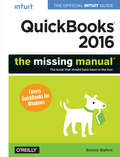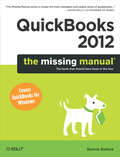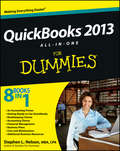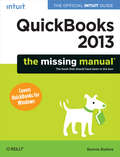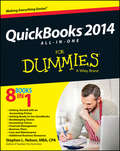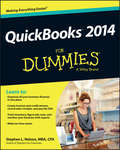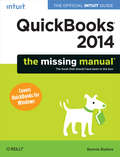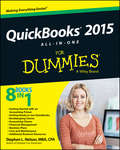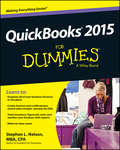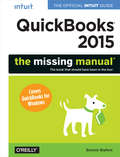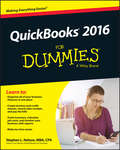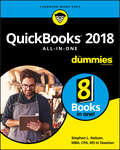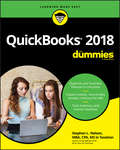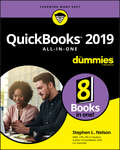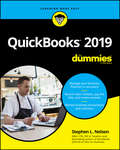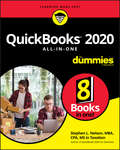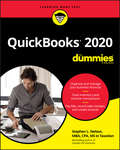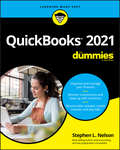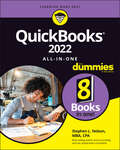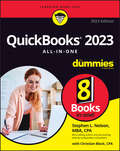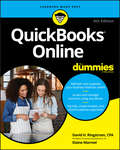- Table View
- List View
QuickBooks 2012: The Missing Manual
by Bonnie BiaforeYour bookkeeping workflow will be smoother and faster with QuickBooks 2012 for Windows--but only if you spend more time using the program than figuring out how it works. This book puts you in control: you get step-by-step instructions on how and when to use specific features, along with basic accounting advice to guide you through the learning process. The important stuff you need to know: Get started. Set up your accounts, customers, jobs, and invoice items quickly. Manage your business. Track spending, income, invoices, inventory, and payroll. Spend less time on bookkeeping. Use QuickBooks to create invoices or timesheets in batches. Follow the money. Examine everything from billable time and expenses to year-end tasks. Find key info quickly. Rely on QuickBooks' vendor, customer, inventory, and employee centers. Exchange data with other programs. Move data between QuickBooks and Microsoft Office.
QuickBooks 2012: The Missing Manual
by Bonnie BiaforeYour bookkeeping workflow will be smoother and faster with QuickBooks 2012 for Windows—but only if you spend more time using the program than figuring out how it works. This book puts you in control: you get step-by-step instructions on how and when to use specific features, along with basic accounting advice to guide you through the learning process.The important stuff you need to know:Get started. Set up your accounts, customers, jobs, and invoice items quickly.Manage your business. Track spending, income, invoices, inventory, and payroll.Spend less time on bookkeeping. Use QuickBooks to create invoices or timesheets in batches.Follow the money. Examine everything from billable time and expenses to year-end tasks.Find key info quickly. Rely on QuickBooks’ vendor, customer, inventory, and employee centers.Exchange data with other programs. Move data between QuickBooks and Microsoft Office.
QuickBooks 2013 All-in-One For Dummies
by Stephen L. NelsonA soup-to-nuts guide to the leading accounting software for small businesses - QuickBooks 2013! Owners of small businesses will love this complete guide to the newest version of QuickBooks, the premier small-business accounting program. Written by CPA and bestselling financial author Stephen L. Nelson, this all-in-one guide includes 8 self-contained minibooks covering every aspect of QuickBooks and how it is used. Coverage includes accounting basics, getting started with QuickBooks, bookkeeping and accounting chores, a short course in financial management, tips on creating a business plan, how to maintain QuickBooks, and some valuable additional resources. Helps you understand basic accounting practices and concepts, customize QuickBooks for your specific needs, and protect your data Explains how to invoice customers, pay vendors, track inventory, and manage cash and bank accounts with QuickBooks Leads you step-by-step through navigating the payroll process, understanding double-entry bookkeeping, preparing financial statements, building a budget, and tackling your taxes Delves into advanced financial strategies like ratio analysis, Economic Value Added analysis, forecasting, and capital budgeting QuickBooks 2013 All-in-One For Dummies is the key to keeping your business–and budget–on track.
QuickBooks 2013: The Official Intuit Guide to QuickBooks 2013 (The\missing Manual Ser.)
by Bonnie BiaforeThe Official Intuit Guide to QuickBooks 2013 for WindowsYour bookkeeping workflow will be smoother and faster with QuickBooks 2013 for Windows, and as the program's Official Guide, this Missing Manual puts you firmly in control. You get step-by-step instructions on how and when to use specific features, along with basic accounting advice to guide you through the learning process.The important stuff you need to know:Get started. Set up your accounts, customers, jobs, and invoice items quickly.Follow the money. Track everything from billable time and expenses to income and profit.Keep your company financially fit. Examine budgets and actual spending, income, inventory, assets, and liabilities.Spend less time on bookkeeping. Use QuickBooks to create and reuse bills, invoices, sales receipts, and timesheets.Find key info fast. Rely on QuickBooks’ Search and Find features, as well as the Vendor, Customer, Inventory, and Employee Centers.Exchange data with other programs. Move data between QuickBooks, Microsoft Office, and other programs.
QuickBooks 2014 All-in-One For Dummies
by Stephen L. NelsonKeep your budget on track and your business booming with QuickBooks 2014 All-in-One For Dummies! QuickBooks is your one-stop shop for taking care of all those financial chores that are essential to keep your small business up and running, and this all-in-one guide makes managing your books easier than ever. Written by CPA and trusted financial author Stephen L. Nelson, this popular For Dummies bestseller has been updated for the latest version of QuickBooks and financial practices. You'll find eight self-contained minibooks that start with the basics of bookkeeping and accounting and walk you all the way through creating business plans and taking advantage of other business resources. Helps you understand accounting procedures and concepts, set up QuickBooks for your business needs, and start speaking the language of finance Explains how to invoice customers, pay vendors, monitor inventory, track accounts, and computer employee wages and payroll deductions Covers important accounting tasks like preparing financial statements, filing taxes, planning a budget, developing a business plan, forecasting, and assessing the health of your business Includes eight minibooks: An Accounting Primer, Getting Ready to Use QuickBooks, Bookkeeping Chores, Accounting Chores, Financial Management, Business Plans, Care & Maintenance, and Additional Business Resources Don't put off those pesky accounting tasks any longer! QuickBooks 2014 All-in-One For Dummies makes managing your business finances a snap and gives you the confidence to tackle the books like a pro.
QuickBooks 2014 For Dummies
by Stephen L. NelsonTake control of the books and keep your finances in the black with QuickBooks and For Dummies With over four million of his books in print, CPA and perennial bestselling For Dummies author Stephen L. Nelson knows how to make QuickBooks and basic accounting easy for the rest of us. Small business owners, managers, and employees: if you want to use QuickBooks for your business, the new edition of this annual bestseller is the best place to start. From setting up the software to creating invoices, recording and paying bills, tracking inventory, getting reports, and crunching numbers for tax prep, you'll discover how to do it, why to do it, and get way more organized in the process. Gives small business owners the power to manage their own business accounting and financial management tasks using QuickBooks 2014 Helps you build the perfect budget, process payroll, create invoices, manage inventory, track costs, generate financial reports, balance accounts, and simplify your tax return prep Walks you through basic bookkeeping concepts, data management fundamentals, and need-to-know accounting guidelines to help you track your finances with ease Keep your business finances on track, on budget, and in control with QuickBooks 2014 and QuickBooks 2014 For Dummies.
QuickBooks 2014: The Official Intuit Guide to QuickBooks 2014
by Bonnie BiaforeHow can you make your bookkeeping workflow smoother and faster? Simple. With this Missing Manual, you’re in control of QuickBooks 2014 for Windows. You get step-by-step instructions on how and when to use specific features, along with basic accounting advice to guide you through the learning process. That’s why this book is the Official Intuit Guide to QuickBooks 2014.The important stuff you need to know:Get started. Quickly set up your accounts, customers, jobs, and invoice items.Learn new features. Get up to speed on the Bank Feed Center, Income Tracker, and other improvements.Follow the money. Track everything from billable time and expenses to income and profit.Spend less time on bookkeeping. Use QuickBooks to create and reuse bills, invoices, sales receipts, and timesheets.Keep your company financially fit. Examine budgets and actual spending, income, inventory, assets, and liabilities.Find key info fast. Rely on QuickBooks’ Search and Find features, as well as the Vendor, Customer, Inventory, and Employee Centers.
QuickBooks 2015 All-in-One For Dummies
by Stephen L. NelsonEverything you need to learn about QuickBooks and small business finances in one handy guide! QuickBooks All-in-One For Dummies is the solution small business owners and managers have been looking for. A compilation of eight content-rich minibooks in one, this guide provides the information and tools you need to get the most out of QuickBooks. Get expert advice from a CPA on common accounting tasks, financial management, business planning, how to protect your financial information and more. Written in the easy-to-read For Dummies style, this book provides clear, concise, practical instruction into taking advantage of everything QuickBooks can do for your business. This book is your roadmap to complete business finance management, guiding you through the basics of QuickBooks, and then taking you even further. You'll start from the beginning and move into more advanced operations as you learn to: Set up, customize, and fine-tune QuickBooks for your business Invoice customers, pay vendors and employees, and track inventory Manage accounts, financial statements, reports, budgets, set up project and job costing, and keep track of payroll Analyze your data to create a business forecast or write a business plan that can help you find your niche Discover useful online resources for businesses More than just a user manual, this guide walks you through topics that are important to small business success. QuickBooks All-in-One For Dummies is a comprehensive guide to keeping your business on track.
QuickBooks 2015 For Dummies
by Stephen L. NelsonKeep your business finances under control easily with QuickBooks If you're like most people involved with a small business, accounting is the last thing you want to spend a lot of time on. Luckily, QuickBooks For Dummies makes it easy to get all the confusing finance stuff out of the way so you can concentrate on other aspects of your growing business. Inside this fun, easy-to-read guide, you'll find out how to manage your financial records, track sales and inventory, pay bills, figure out job costs, and more. With easy-to-follow guidance and plain-English explanations that cut through the financial jargon, this resource shows you how to get started with QuickBooks, populate QuickBooks lists, create invoices and credit memos, record sales receipts, set up inventory items, record and pay bills, track business checkbooks and credit cards, print checks, build a budget, generate financial reports, and so much more. Walks you through installing the software and configuring QuickBooks for your business needs Shows you how to write checks, set up payroll reminders, and keep the payroll rolling Covers how to securely download bank and credit card transactions, as well as how to pay bills online Provides easy-to-follow steps for keeping track of your checkbook, credit and debit accounts, inventory, payroll, and budgets Written by a CPA who knows QuickBooks and understands your unique business needs, QuickBooks For Dummies is your go-to guide for getting past the paperwork and putting the program to work.
QuickBooks 2015: The Official Intuit Guide to QuickBooks 2015
by Bonnie BiaforeHow can you make your bookkeeping workflow smoother and faster? Simple. With this Missing Manual, you’re in control: you get step-by-step instructions on how and when to use specific features, along with basic bookkeeping and accounting advice to guide you through the learning process. Discover new and improved features like the Insights dashboard and easy report commenting. You’ll soon see why this book is the Official Intuit Guide to QuickBooks 2015.The important stuff you need to know:Get started fast. Quickly set up accounts, customers, jobs, and invoice items.Follow the money. Track everything from billable and unbillable time and expenses to income and profit.Keep your company financially fit. Examine budgets and actual spending, income, inventory, assets, and liabilities.Gain insights. Open a new dashboard that highlights your company’s financial activity and status the moment you log in.Spend less time on bookkeeping. Create and reuse bills, invoices, sales receipts, and timesheets.Find key info. Use QuickBooks’ Search and Find features, as well as the Vendor, Customer, Inventory, and Employee Centers.
QuickBooks 2016 For Dummies
by Stephen L. NelsonThe perennial bestseller on QuickBooks—now covering QuickBooks 2016 If you're like most people involved with a small business, accounting is the last thing you want to spend a lot of time on. Luckily, QuickBooks 2016 For Dummies makes it easy to keep your finances under control so you can concentrate on other aspects of your business. In no time, you'll find out how to populate QuickBooks lists, create invoices and credit memos, record a sales receipt, track sales and inventory, pay bills, process payroll, track business checkbooks and credit cards, and so much more. QuickBooks is the leading small business accounting software package designed to help users handle their financial and business management tasks more effectively. With plain-English explanations that cut through financial jargon, this easy-to-follow guide walks you through installing the software and configuring QuickBooks for your business needs and goes on to show you how to build the perfect budget, simplify tax return preparation, and generate financial reports—without ever breaking a sweat! Organize all of your business finances in one place Create invoices and credit memos, record sales receipts, and pay the bills Track inventory, figure job costs, and monitor your business with reports Make tax time easier Written by an expert CPA who knows QuickBooks and understands your unique business needs, QuickBooks 2016 For Dummies is your go-to guide for getting past the paperwork and putting the program to work.
QuickBooks 2016: The Official Intuit Guide to QuickBooks 2016
by Bonnie BiaforeHow can you make your bookkeeping workflow smoother and faster? Simple. With QuickBooks 2016: The Missing Manual (which covers the Windows version of QuickBooks), you’re in control: you get step-by-step instructions on how and when to use specific features, along with basic bookkeeping and accounting advice to guide you through the learning process. Discover new and improved features like the Insights dashboard and easy report commenting.The important stuff you need to know:Get started fast. Quickly set up accounts, customers, jobs, and invoice items.Follow the money. Track everything from billable and unbillable time and expenses to income and profit.Keep your company financially fit. Examine budgets and actual spending, income, inventory, assets, and liabilities.Gain insights. Open a dashboard that highlights your company’s financial activity and status the moment you log in.Spend less time on bookkeeping. Create and reuse bills, invoices, sales receipts, and timesheets.Find key info. Use QuickBooks’ Search and Find features, as well as the Vendor, Customer, Inventory, and Employee Centers.
QuickBooks 2018 All-in-One For Dummies
by Stephen L. NelsonThe easy way to manage business finances QuickBooks is known for helping their users effectively handle their financial and business management tasks, and QuickBooks 2018 All-in-One For Dummies is the go-to guide for anyone looking to gain insight into the latest version of the software. It gets you up to speed on the key features of QuickBooks and small business accounting and makes managing finances a breeze. This book will help you learn all the skills you need to know, like how to invoice customers, pay vendors, manage cash and bank accounts, use activity-based costing, and write a business plan. Written by highly qualified CPA Stephen L. Nelson, this detailed reference combines eight mini-books into one complete resource. Small business finances can be complicated, but QuickBooks 2018 is a valuable tool for getting them right—and this guide makes it easier. Troubleshoot and protect your financial data Utilize Cloud storage and access your information from a smartphone Plan and set up a QuickBooks system Make sense of double-entry bookkeeping Handle your financial and business management tasks more effectively QuickBooks 2018 All-in-One For Dummies is a helpful resource for getting started with QuickBooks 2018, and a reference guide that will provide insight and answers to experienced users as well.
QuickBooks 2018 For Dummies
by Stephen L. NelsonThe perennial bestseller—now in a new edition for QuickBooks 2018 QuickBooks 2018 For Dummies is here to make it easier than ever to familiarize yourself with the latest version of the software. It shows you step by step how to build the perfect budget, simplify tax return preparation, manage inventory, track job costs, generate income statements and financial reports, and every other accounting-related task that crosses your desk at work. Written by highly qualified CPA Stephen L. Nelson, this trusted bestseller shows you how to get the most out of the software that helps over six million small businesses manage their finances. Removing the need to hire expensive financial professionals, it empowers you to take your small business' finances into your own hands. Handle your financial and business management tasks more effectively Implement QuickBooks and get the most out of its features Create invoices and credit memos with ease Pay bills, prepare payroll, and record sales receipts If you're a small business owner, manager, or employee who utilizes QuickBooks at work, this bestselling guide has answers for all of your business accounting needs.
QuickBooks 2019 All-in-One For Dummies
by Stephen L. NelsonThe quickest way to do the books! Finances don’t have to put you in a funk! With the help of this all-encompassing book, you’ll get the easy-to-follow instruction you need to get your business’ ducks in a row—without ever losing your cool. Whether you’re a numbers person or have never spent much time with a calculator, you’ll discover how to use QuickBooks 2019 to make it easier than ever to handle your finances. This value-priced reference combines eight content-rich mini-books into one complete package, providing the answers you need to get the most out of the latest version of QuickBooks. No stone is left unturned, giving you everything you need to turn what used to be harrowing tasks into simple items you can check off on your to-do list. Helps you use QuickBooks to ease accounting chores, financial management, and business planning Provides guidance from an industry expert Shows you how to set up a QuickBooks accounting system, load the master files lists, invoice customers, pay vendors, track inventory, manage cash and bank accounts, and more Gives helpful troubleshooting tips to make your accounting easy Your time is precious—why waste a minute when QuickBooks can make it easier? Get started today!
QuickBooks 2019 For Dummies
by Stephen L. NelsonThe bestselling guide to QuickBooks—now in a new edition QuickBooks 2019 For Dummies is here to make it easier than ever to familiarize yourself with the latest version of the software. It shows you step by step how to build the perfect budget, simplify tax return preparation, manage inventory, track job costs, generate income statements and financial reports, and every other accounting-related task that crosses your desk at work. Written by CPA Stephen L. Nelson, this perennial bestseller shows you how to get the most out of the software that helps over six million small businesses manage their finances. Removing the need to hire expensive financial professionals, it empowers you to take your small business' finances into your own hands. Handle your financial and business management tasks more effectively Implement QuickBooks and get the most out of its features Create invoices and credit memos with ease Pay bills, prepare payroll, and record sales receipts If you're a small business owner, manager, or employee who utilizes QuickBooks at work, this bestselling guide has answers for all of your business accounting needs.
QuickBooks 2020 All-In-One For Dummies
by Stephen L. NelsonThe quickest way to do the books for small business owners and managers No one looks forward to doing the finances: that’s why QuickBooks 2020 All-in-One For Dummies is on hand to help get it over with as quickly and painlessly as possible. This comprehensive one-stop reference combines 8 mini-books in one, all written in plain and simple language that makes it easy for even the most accounts-averse to get the most out of the latest version of the QuickBooks software and save time. Written and revised by financial expert Stephen Nelson, the latest version of this invaluable guide takes readers step-by-step through every aspect of small business accounting procedures, including understanding the fundamentals of double-entry bookkeeping, setting up and administering the QuickBooks system, and carrying out complex tasks such as ratio analysis and capital budgeting. Write a business plan and create a forecast Learn how to use profit-volume-cost analysis tools Prepare financial statements and reports Protect your financial data Time is money—get this time-saving resource today and start reaping the rewards!
QuickBooks 2020 For Dummies
by Stephen L. NelsonThe perennial bestseller—now in a new edition QuickBooks allows small businesses to manage their own accounting and financial management tasks—without needing to hire expensive financial professionals. This perennial bestseller is here to show you step by step how to build the perfect budget, simplify tax return preparation, manage inventory, track job costs, generate statement and financial reports, and every other accounting-related task that crosses your desk. Written by CPA Stephen L. Nelson, it shows you how to get the most out of the software that helps over six million small businesses manage their finances. Handle your financial and business management tasks more effectively Get the most out of QuickBooks’ features Create invoices and memos with ease Pay bills, prepare payroll, and record sales receipts If you use QuickBooks at work—or want to implement it in 2020—this book has you covered.
QuickBooks 2021 All-in-One For Dummies
by Stephen L. NelsonDo the numbers in double-quick time with this trusted QuickBooks bestseller! Running your own business can be cool, but some of the financial side—accounting and payroll, for instance—is not always so cool! That’s why millions of small business owners around the world bank on QuickBooks to easily manage accounting and financial tasks and save big-time on shelling out for an expensive professional. QuickBooks 2021 All-in-One For Dummies contains eight information-rich mini-books that account for all your financial line-item asks, showing you step-by-step how to plan your perfect budget, simplify tax returns, manage inventory, create invoices, track costs, generate reports, and accurately check off every other accounting and financial-management task that comes across your desk! Get the most out of QuickBooks 2021 Sharpen up on the basics with an accounting primer Craft a world-class business plan Process taxes and payroll in double-quick time Written by expert CPA and small business advisor Stephen L. Nelson, QuickBooks All-in-One 2021 For Dummies is the best-selling blue-chip go-to that will save you time and money—and will allow you to enjoy the fruits of your labors!
QuickBooks 2021 For Dummies
by Stephen L. NelsonSave on expensive professionals with this trusted bestseller! Running your own business is pretty cool, but when it comes to the financial side—accounts and payroll, for instance—it's not so cool! That’s why millions of small business owners around the world count on QuickBooks to quickly and easily manage accounting and financial tasks and save big time on hiring expensive professionals. In a friendly, easy-to-follow style, small business guru and bestselling author Stephen L. Nelson checks off all your financial line-item asks, including how to track your profits, plan a perfect budget, simplify tax returns, manage inventory, create invoices, track costs, generate reports, and pretty much any other accounts and financial-planning task that turns up on your desk! Keep up with the latest QuickBooks changes Use QuickBooks to track profits and finances Balance your budget Back up your data safely The fully updated new edition of QuickBooks For Dummies takes the sweat (and the expense) out of cooking the books—and gives you more time to savor the results of your labors!
QuickBooks 2022 All-in-One For Dummies
by Stephen L. NelsonThe soup-to-nuts QuickBooks reference that will make your small business life so much simpler! QuickBooks makes it quick to do your books, and QuickBooks 2022 All-in-One For Dummies makes it easy. The leading small business accounting software will become your best friend, helping you cut costs (no more expensive financial services) and save time, with all your accounting and payroll info in one place. With this value-priced, bestselling reference, you’ve got access to 8 mini-books that give you the answers you need to make running a small business that much more manageable. Inside, you’ll discover the key features of QuickBooks, plus refresh your memory on double-entry bookkeeping and all the other basics of small business accounting. This jargon-free guide shows you, step-by-step, how to plan your perfect budget, simplify tax returns, manage inventory, create invoices, track costs, generate reports, and accurately check off every other financial task that comes across your desk! Get the most out of QuickBooks 2022, including all the latest features and updates Sharpen your finance and accounting know-how with a friendly rundown of the must-knows Keep yourself in business with a solid budget, a world-class business plan, and clean payroll Take the headache out of tax time with QuickTime’s automated tax preparation QuickBooks All-in-One 2022 For Dummies is the trusted go-to that will save you time and allow you to focus on the business of running your small business!
QuickBooks 2023 All-in-One For Dummies
by Stephen L. NelsonThe quickest way to learn everything there is to know about QuickBooks QuickBooks is the leading small business accounting software, designed to help you handle your financial and business tasks more effectively. QuickBooks 2023 All-in-One For Dummies answers all your QuickBooks questions, with 8 content-rich mini books in one complete package. You can get the most out of the latest QuickBooks release, thanks to this go-to reference covering account setup, double entry bookkeeping, invoicing customers, paying vendors, tracking inventory, creating a business plan, cloud storage, and everything else QuickBooks can do for you. Plus, you can access your information from any device with new online features, making it easy to manage your business on the go. Dummies walks you through everything, step by step. Set up QuickBooks for your small business and import all your accounts and data Manage invoices, payments, and inventory—and see it all on quick statements and reports Make the most of the latest version of QuickBooks with this updated guide Use economic value-added analysis and other analysis tools to identify potential savings and profit opportunitiesSmall business owners, managers, and employees who use QuickBooks already or want to switch to the leading software package will find everything they need in QuickBooks 2023 All-in-One For Dummies.
QuickBooks 2024 All-in-One For Dummies
by Stephen L. NelsonThe quick way to get started—and get proficient—with QuickBooks QuickBooks 2024 All-in-One For Dummies is the solution small business owners and managers are seeking. This high-value reference combines 8 content-rich mini-books into one complete package, providing the answers you need to get the most out of the 2024 version of QuickBooks. You’ll learn the key features of QuickBooks and small business accounting, including setting up the software, understanding double-entry bookkeeping, invoicing customers, paying vendors, tracking inventory, creating reports, and beyond. Plus, you’ll discover how you can use cloud storage to access your information on your smartphone, making running a small business that much more manageable. Sign up for QuickBooks software, set up your accounts, and customize your preferences Learn the basics of accounting and bookkeeping, and make sure you’re doing it right Discover advanced features of QuickBooks that will help you run your business smoothly and efficiently Save money by confidently managing your finances yourself This beginner-friendly Dummies guide makes it a breeze for small business owners, managers, and employees to implement QuickBooks at work.
QuickBooks Desktop All-In-One For Dummies
by Stephen L. NelsonAn all-encompassing guide to a popular desktop accounting software QuickBooks Desktop All-in-One For Dummies clearly guides you on how to manage your business finances through QuickBooks Desktop. This comprehensive resource walks you through advanced features and overall layout, so you can maximize the value this software brings to your business. Feel confident invoicing customers, paying vendors, tracking inventory, do-it-yourself payroll, preparing financial statements and reports, creating a business plan forecast, and more. Plus, you'll get helpful tips for protecting your financial data and troubleshooting any potential snags along the way. Inside: Get started with QuickBooks Desktop and set up your accounting system Get easy-to-follow instructions for saving time with easy bookkeeping and automated features Learn to use advanced features as your business grows, so you can scale for the future Know your tax and reporting requirements From QuickBooks Desktop setup and bookkeeping basics to importing your data and performing all the tasks you need to keep things running smoothly, QuickBooks Desktop All-in-One For Dummies is your go-to
QuickBooks Online For Dummies
by Elaine Marmel David H. RingstromMaster the world’s most popular cloud software for bookkeeping and accounting. QuickBooks Online For Dummies, 6th Edition collects and provides the best and most current information available for those looking to get the most out of the leading QuickBooks Online software. Perfect for small business owners, managers, and employees, QuickBooks Online For Dummies delivers the newest and most up-to-date advice based on the latest versions of QuickBooks Online. The 6th Edition is written by a seasoned author of more than seventy books. Whether you’re a QuickBooks Online newbie or seasoned pro, you’ll find actionable and accessible advice in this new edition. Get tips on: · Creating invoices and credit memos · Recording sales receipts · Recording and paying bills · Setting up inventory items · Tracking business checkbook and credit cards · And more No longer will you have to struggle through your interactions with the most used bookkeeping and accounting software in the world. Master this technology with the straightforward and accessible approach made famous by the For Dummies series.
